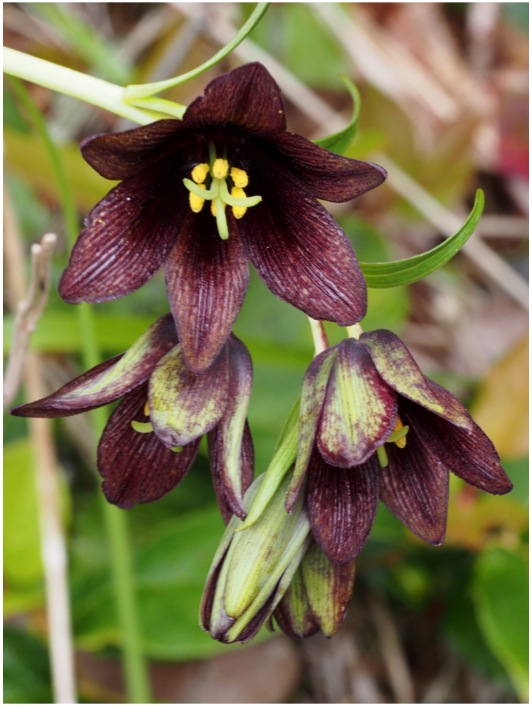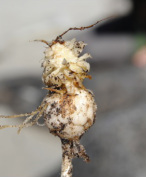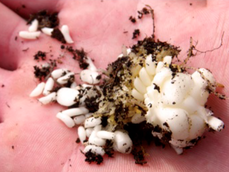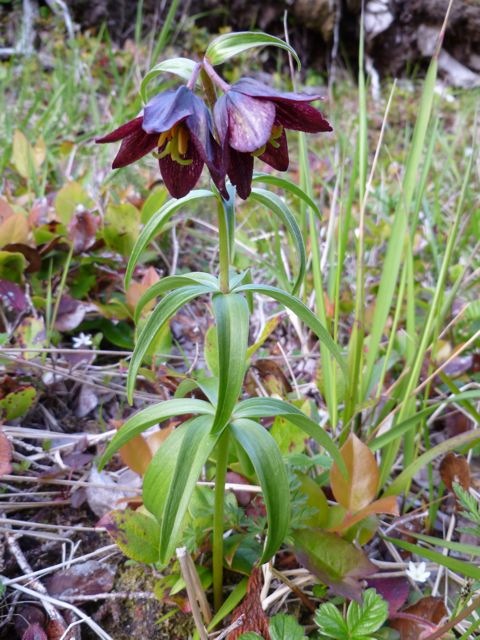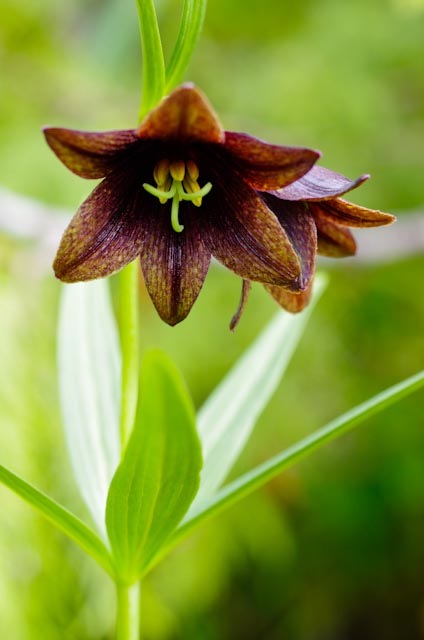Northern rice root, Northern rice-root, Black lily • Fritillaria camschatcensis
Left: Northern rice root bulbs and bulbets. Photos by Georgia Brander (top) and Stuart Higgs (bottom). Flowering northern rice root photos by Misha Warbanski (top left), Georgia Brander (top right), Kira Hoffman (bottom right), and an ES 470 participant.
Identification
Northern rice root is easily recognizable in the spring when in flower, with large, nodding dark brown flowers in groups of two or three. It grows from 20-60 cm tall and has grass-like leaves growing in groups from the stem. It is a perennial, growing from a bulb with rice-like bulblets.
Habitat & Range
Northern rice root grows in moist open places near the coast, including meadows, open forests, streambanks, immediately along shorelines and in estuaries and salt marshes. It can be found from sea level to subalpine elevations and is ubiquitous in coastal British Columbia, extending south to coastal Washington and Oregon and north to Alaska and the Yukon.
Associated species
In the Squamish Estuary, false lily-of-the-valley (Maianthemum dilatatum) and Douglas aster (Aster subspicatus) act as indicators for where northern rice root can grow (Joseph, 2012).
Similar Species
Northern rice root is sometimes confused with chocolate lily (Fritillaria lanceolata or F. affinis) a more southern species generally not found on the Central Coast. Its flowers are usually singular or in less clumped groups, are mottled with greenish-yellow patches, and droop over more than chocolate lily flowers.
Human Uses
Most First Nations in British Columbia and the Pacific Northwest cultivated northern rice root in estuarine root gardens. They usually harvested the smaller rice-like bulblets and replanted the larger 'grandmother' bulb. The bulbs provided an important source of sugar and starch, and were often eaten with eulachon oil or grease. Changes in access to and degradation of traditional harvest areas have limited use of this food in recent years, and there is interest in ecocultural restoration of cultivation practices among members of the Squamish Nation (Joseph, 2012) and likely other First Nations in the region.
Northern rice root is easily recognizable in the spring when in flower, with large, nodding dark brown flowers in groups of two or three. It grows from 20-60 cm tall and has grass-like leaves growing in groups from the stem. It is a perennial, growing from a bulb with rice-like bulblets.
Habitat & Range
Northern rice root grows in moist open places near the coast, including meadows, open forests, streambanks, immediately along shorelines and in estuaries and salt marshes. It can be found from sea level to subalpine elevations and is ubiquitous in coastal British Columbia, extending south to coastal Washington and Oregon and north to Alaska and the Yukon.
Associated species
In the Squamish Estuary, false lily-of-the-valley (Maianthemum dilatatum) and Douglas aster (Aster subspicatus) act as indicators for where northern rice root can grow (Joseph, 2012).
Similar Species
Northern rice root is sometimes confused with chocolate lily (Fritillaria lanceolata or F. affinis) a more southern species generally not found on the Central Coast. Its flowers are usually singular or in less clumped groups, are mottled with greenish-yellow patches, and droop over more than chocolate lily flowers.
Human Uses
Most First Nations in British Columbia and the Pacific Northwest cultivated northern rice root in estuarine root gardens. They usually harvested the smaller rice-like bulblets and replanted the larger 'grandmother' bulb. The bulbs provided an important source of sugar and starch, and were often eaten with eulachon oil or grease. Changes in access to and degradation of traditional harvest areas have limited use of this food in recent years, and there is interest in ecocultural restoration of cultivation practices among members of the Squamish Nation (Joseph, 2012) and likely other First Nations in the region.
References
Anonymous. (2012). Fritillaria camschatcensis (L.) Ker Gawl. In Klinkenberg, Brian. (Ed.). E-Flora BC: Electronic Atlas of the Plants of British Columbia [eflora.bc.ca]. Lab for Advanced Spatial Analysis, Department of Geography, University of British Columbia, Vancouver. Accessed on 12/13/2012.
Joseph, L. (2012). Finding our roots: ethnoecological restoration of lhasem (Fritillaria camschatcensis (L.) Ker-Gawl), an iconic plant food in the Squamish River Estuary, British Columbia (Master's thesis). Accessed on 12/12/12.
Pojar, J. and MacKinnon, A. (2005). Plants of Coastal British Columbia, Revised. Vancouver, BC: Lone Pine Publishing. P. 110.
Authors and editors of page
Chanda Brietzke and Brian Starzomski (2013).
Anonymous. (2012). Fritillaria camschatcensis (L.) Ker Gawl. In Klinkenberg, Brian. (Ed.). E-Flora BC: Electronic Atlas of the Plants of British Columbia [eflora.bc.ca]. Lab for Advanced Spatial Analysis, Department of Geography, University of British Columbia, Vancouver. Accessed on 12/13/2012.
Joseph, L. (2012). Finding our roots: ethnoecological restoration of lhasem (Fritillaria camschatcensis (L.) Ker-Gawl), an iconic plant food in the Squamish River Estuary, British Columbia (Master's thesis). Accessed on 12/12/12.
Pojar, J. and MacKinnon, A. (2005). Plants of Coastal British Columbia, Revised. Vancouver, BC: Lone Pine Publishing. P. 110.
Authors and editors of page
Chanda Brietzke and Brian Starzomski (2013).
